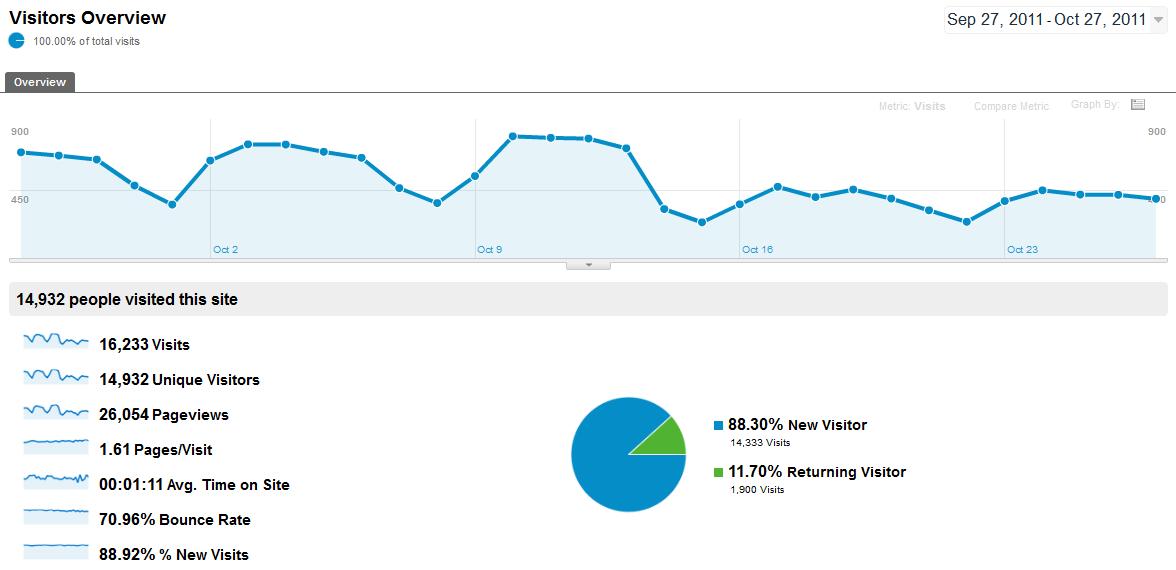Your cart is currently empty!

Lab Report: Panda Updates
On October 13th, Google updated its search algorithm, causing seriously reduced search traffic for a lot of websites. This analytics screen shot shows that our lab site, FreshPlans, was one of them. The left side of the screen shows our typical traffic, while the right side shows our traffic beginning on October 14th. As the pie graph shows, this site gets nearly all its traffic from organic search, so our loss of search engine oomph had a striking effect on our traffic.
Just to clarify, the loss was only from Google. Here’s a shot of our traffic from Bing during the same time period, rising steadily as the traffic for this site normally does:
While no one is ever happy to have a loss like this, we’re glad to have the opportunity to experience the Panda smackdown. We usually benefit from Google algorithm updates, so we haven’t previously had the chance to learn what it takes to recover from one.
My personal response to criticism is first to see whether there’s any merit in it, so I figure the first response to a negative move like this is to check the quality of the site.  Has our design become outdated? Are our pages slow? Have we gotten lax about providing good quality, useful content? Is our code old fashioned?
Has our design become outdated? Are our pages slow? Have we gotten lax about providing good quality, useful content? Is our code old fashioned?
We’re feeling pretty good about FreshPlans. We did put ads on it during back to school, but we think it’s still a valuable resource for our target audience.
I checked Google Webmaster Tools to make sure that I wasn’t missing anything. Webmaster Tools tell you if your pages are slow or there are other technical problems, and they also show the keywords Google thinks are relevant for your site. For ours, phrases like “classroom,” “books,” and “lesson plans” are just what we have going on, so we feel pretty good still. We also checked Google’s official advice for improving search results.
Interestingly, when we checked on Search Queries, we found that there had not, as far as Google was concerned, been much of a negative change.
This shows queries and click through rate and average position for the top search queries for the same period as the screen shot at the beginning of the post — quite a difference! We’re in the red for a few terms, but there is nothing here to explain why we’ve lost half our search traffic.
Balked of any clear evidence from good sources, we turned to gossip.
We found two theories circulating. First, there were suggestions that location data was making a difference. FreshPlans, unlike every other site we work with, is not associated with a business, so we had no location on it. I went and put our address on the About us page, just in case.
The second is that bounce rate is being used to flag sites.
FreshPlans has a high bounce rate, about 70%. That’s a high bounce rate in the overall scheme of things, but it’s common for blogs. People go to a business site’s home page, typically, and then navigate through the site checking it out and finding out what the company does. At a blog, however, they tend either to come every day and read the post for that day, or to come through search for something specific, and leave happy. We don’t really expect that people looking for logic lesson plans (we used to be #1 for that query) as they get ready for class will decide to hang out and look at lesson plans on Rapunzel. So we’ve never been concerned about the bounce rate.
We’re seeing in the forums that old, established sites with high bounce rates (for reasons like ours) have also suffered from the 10/13 change.
Our working hypothesis, then, is that we need to improve our bounce rate in order to get our search traffic back. We’ll keep you posted on the progress of this experiment.
by
Tags:



Leave a Reply